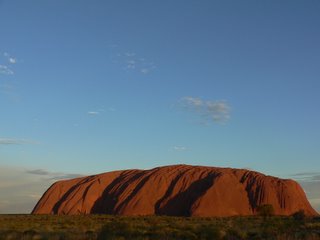 Call of the Rocks
Call of the RocksThe airplane circling around Connellan airport seemed reluctant to land, allowing us a clear sight of the rock we had flown miles to see. Set amidst a huge expanse of barren red earth, Ayers Rock was from air, a giant blob of mud. It was a first glimpse that left us a bit bemused – what was all the fuss about, really!
The airport itself was familiar in an Indian sort of way – we walked through a blazing hot tarmac to the airport building. But the sky was a clear blue, the air fresh. And the free shuttle bus to the hotel was mercifully air-conditioned.
The hotel in question was The Desert Garden Hotel, one of about 4 available, all part of the Ayers Rock Resort. Accommodation does not come cheap here in Yulara, the service village for the Uluru-Kata Tjuta National Park. There is a restriction on development in the area, and land is leased by the park authorities from the aboriginal tribe for whom the area is sacred. Which means tourists pay quite a high price for the photo-op with Australia’s most famous rock.
The Resort itself is quite well-laid out and caters very nicely to tourist requirements. Our hotel room had a balcony that had a direct view of Uluru and so we could literally have a view of the rock through the day. Food at the resort is expensive and so as typical budget travelers, we made do with supermarket sandwiches and colas.
After all the hype, one would expect Ayers Rock or Uluru (as the original inhabitants of the land call it) to disappoint. Gratifyingly, it does not. Our first terrestrial sight of it was from a designated viewing spot en route to Kata Tjuta (or the Olgas as the white men named it), Uluru’s sister formation of rocks in the desert. The uniqueness of Uluru strikes you immediately. This is not something you have seen before and it is unlikely you will see something like it again - a massive piece of rock, the 2nd biggest monolith in the world, rising up from miles of red-earthed desert. Its geological oddity is intriguing – almost as mystifying as the aboriginal legend that accompanies it. Geologists say that Uluru (and Kata Tjuta) is the tip of a huge piece of rock that continues more than 5 or 6 kilometres below ground. In a complex explanation (most of which went over my head), they say it was formed over 350 million years ago, through a series of foldings and tiltings of the earth’s crust and erosion. Erosion of course still goes on and because some parts of Uluru are made of softer rock, they erode faster and this uneven erosion gives Uluru its peculiar features of ridges, grooves and caves.
For The Anangu, the aborigines who live here, Uluru is an extremely sacred place. Each ridge and groove on Uluru’s surface has a deep significance for them, signifying events in their ancestor’s lives. These ancestral stories are not easily shared with outsiders but we heard one such story around the Mutitjulu watering hole. It’s a half hour walk to the watering hole and on a hot summer day, it seemed longer. It was a story of inter-tribal warfare and a snake mother’s wrath and vengeance. For the Anangu, each of those incidents are etched on Uluru’s rock in its myriad grooves and marks and with a little imagination, you can watch the story come alive. The Mutitjulu watering hole is also a site of aboriginal cave paintings – bright and colourful with the characteristic symbols of aboriginal art.
Mutitjulu is just one of the many sites around Uluru that hold such myths and stories. Because this rock holds such significance for the aboriginal people, they request people not to climb it. It would take someone really insensitive to ignore this request. But there are enough tourists who climb Uluru every year, nevertheless. Why the authorities don’t just forbid climbing Uluru is baffling, especially when there seems to be enough consciousness in Australia about aboriginal rights. You can walk around Uluru on a 9 km trail that can be quite tiring on a blazing hot summer day. But a guided walk can open your eyes to aboriginal culture and their dreamtime stories. There are also other shorter walks available including the Mutitjulu walk and you can choose to exert yourself only as much as you want to.
Sunrises and sunsets on Uluru are fascinating to watch. As the sun moves across the sky, the colour of Uluru changes from a deep dark chocolate brown to fiery red (it looks red because of the rusting of the iron ore in the rock – it is originally plain gray) and back again to the deep brown. They say that during thunderstorms, Uluru turns a magnificent royal purple! We didn’t get to see any thunderstorms of course, and so had to take our local guide’s word for it.
Kata Tjuta, unlike Uluru is not a monolith. But this grouping of rocks around 30 km west of Uluru, does not lack drama either, set as it is against the barrenness of the landscape around. There are fascinating walks through and around Kata Tjuta too, the most famous being the Valley of Winds walk, a 7.5 km stretch that takes you through some fascinating gorges. But if you choose to go at the height of summer, chances are that this walk would be closed. At temperatures above 36 degrees Celsius, park authorities consider it unsafe for visitors to attempt this long walk. But again, there are shorter walks, like the Olga Gorge walk, that takes you up a gorge for a look at interesting rock faces set against the deep blue sky. Kata Tjuta is sacred too, to the aborigines and it has its own set of stories that are passed down through generations of local tribes. Again, a lot of these stories are classified and not shared with outsiders. But there are a few on display at the Uluru-Kata Tjuta National Park Cultural Centre. It is an interesting museum of sorts, with exhibits of Anangu art and explanations of Aboriginal law, religion and custom. One can end up spending a fair bit of time here and if you have money to spare, you can even end up with a rare collection of Aboriginal art.
Our two days at Ayers Rock were just right. Two sunset trips and a sunrise one to the most famous rocks in Australia gave us enough opportunity to take in glimpses of an ancient fragile culture that is so terribly endangered. And of course, to take some really cool photographs for people back home.





